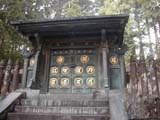Nikkou
I went Nikkou where were many sightseer,
because this year is a 350 years after Iemisu tokugawa who is a 3rd Sho-gun in Edo era died and sleeped there,
because the temples were admitted as the legacy of the world,
because there are tombs of three Sho-gun whom are hero of "Three Tokugawa Sho-gun" what is now broadcasted on NHK(Nippon Houso Kyo-kai).
There are a lot of large old temples in Nikkou.
It shows the power of Tokugawa Sho-gun in Edo era.
Nikkou is placed the north-east from Edo(old Tokyo), where is a bad direction based on old legend.
Ieyasu Tokugawa who is a first Sho-gun of Edo era have a small old temple bulid biggest temple.
Tenkai who was an adviser of a acient three Tokugawa Sho-guns became the master of the temple on Edo era.
Ieyasu Tokugawa built his tomb in the temple.
But he became one of a Japanese Gods instead of Hotoke.
So he and his child built new shrine in Nikkou.
In other words, there are Big temple and shrine in Nikkou for Ieyasu and Edo Bakufu.
In an old Japan, it was no difference between Gods and Hotoke.
These building made by Tokugawa Sho-guns are very big, large, beautiful.wonderful
This is a Sho-you garden, where is drinking green tea for Sho-gun family.
It was a small and beautiful garden.

And there is a main building of temple.
There are three Hotoke, Batoh Kan-non, Amida Nyorai, Senju Kan-non.
Three Hotoke sculptures are made by Katsura wood, but they are shining like metals.
#I am sorry no pictures because they cannot be taken pictures.

This is the entrance of To-sho-gu, Ieyasu's shrine.
This shrine is equal to a Ieyasu's tomb.
They are much larger, more beautiful, richer than temple buildings.

This is a tower.

This is a famous relief on the wall of holy horse house, whose motives are
no seeing monky, no listening monky and no saying monkey.
It was a good spot for taking memorial picture.
However, there are many reliefs in the shrine areas, and other ones are very beautiful and good.

There is "Youmei Gate"(whose meaning is shining).
Another name is "Higurashi Gate" (whose meaning is evening) because everyone cannot stop seeing this gate till evening.
It was regretted rain falls a little, so I can only a little pieces photographs.
The gate has good, beautiful and rich reliefs.
The characteristic of the gate is a couple of reliefs are existed, though only one is enough for religion.
Exactly, it is extremely rich.
I wonder how many artists build them.

This is also famous relief, sleeping cat on the second gate of tomb.
It shows sleeping cat under the sun-shine, but I didn't see it.
Then, it needs more 500 yen for sightseeing.

This is the last gate for protecting Ieyasu's tomb.

This is the tomb.
It is made in metal.

They are Mikoshi for aniversary.
They are appeared in Every March 17th which may be the day of Ieyasu's death.

There are many sightseeing points, for instance, To-sho-gu palace, dragons sounds, but almost all cannot be taken photograph,
The dragon sounds is a sound at the special position reflects between cell and floor, and the reflected sounds like dragon's.
It is very mysterious, and good.
Next, I went a Taiyu-in, where is a tomb of 3rd Sho-gun Iemitsu.
My aim to visit Taiyu-in is seeing an Iemitsu's secret tomb which are especially displayed for this half year.
This is a drawing of holy lady on the cell of the first gate of opend secret tomb.

This is the final gate of tomb.
It is no difference from Ieyasu's.

And, this is the tomb.
It is smaller than Ieyasu's because it may be his respect.

I was regret that I didn't have enough time to see them.
And, it rained.
Nikkou building are very large, we need to see them whole a day.
But, I was surprised,
How expensive!
It takes 2200 yen to sightsee the above route.
And moreover, It was said everywhere, "please buy holy accessary and holy paper."
Huum. it was truth preast make money.
Yas's Page in Japanese
My travel page in Japanese
mail to yas@kanagawa.email.ne.jp












